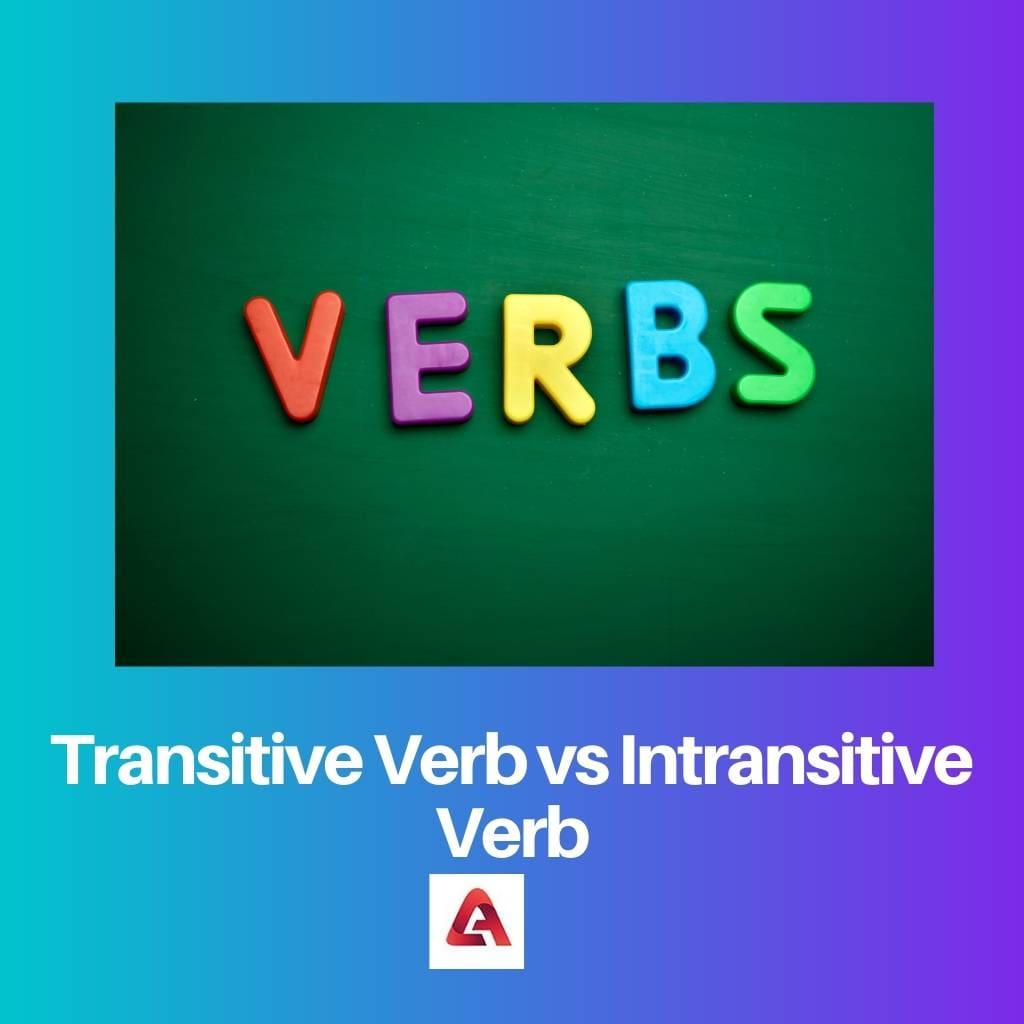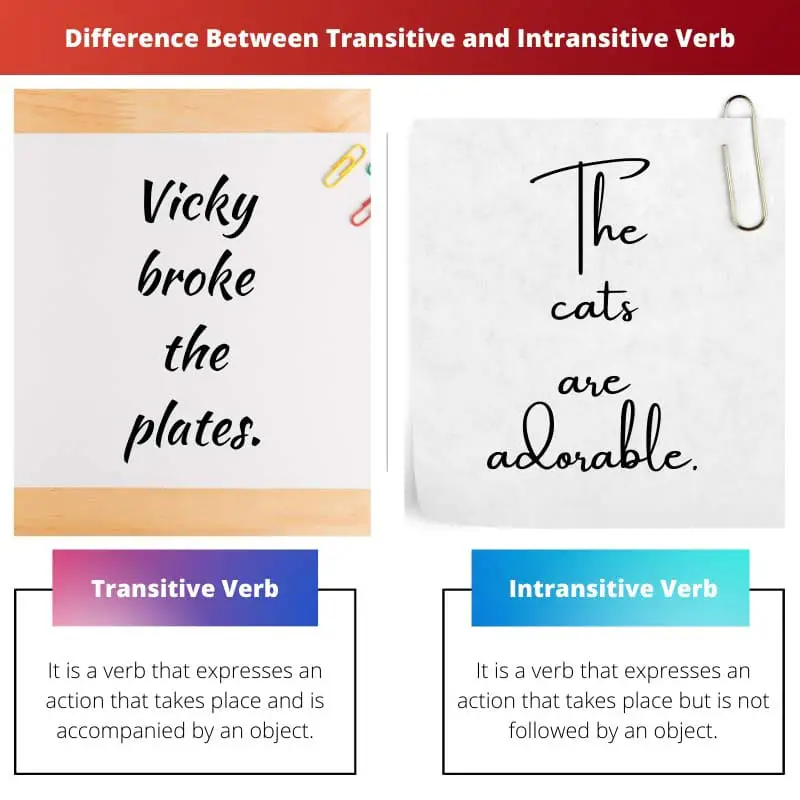As more and more people seek employment opportunities beyond the boundaries of their country, becoming multi-lingual is now a necessity. English is the most widely spoken language in global companies and businesses, therefore, being well-conversant in English can be a feather to your hat.
But it takes dedication and an eye for detail to learn a language. New English speakers get confused between verbs, prepositions, conjunctions, or adverbs. Especially verbs are so tricky that even fluent speakers get confused between transitive and intransitive verbs.
Key Takeaways
- Transitive verbs require an object to complete their meaning.
- Intransitive verbs do not require an object to complete their meaning.
- The object of a transitive verb receives the verb’s action, while the subject of an intransitive verb acts.
Transitive Verb vs Intransitive Verb
A transitive verb is a verb that requires an object to complete its meaning, where the object is the receiver of the action performed by the verb. An intransitive verb is a verb that does not require an object to complete its meaning, used to express an action that does not require an object.

A transitive verb is a verb that expresses an action that takes place and is followed by an object, without which the sentence would not make sense. Transitive verbs are used in the construction of passive sentences.
For instance, “Sonya fries the chicken”. In this sentence, the verb is ‘fries’ and it is followed by an object, that is, ‘chicken’. The sentence would have remained incomplete without the object.
An intransitive verb is a verb that expresses an action that takes place but is not followed by an object. The sentence makes complete sense even without it. Sentences with intransitive verbs in them are not quite complex.
For instance, “Ronita cried.” The verb in this sentence is ‘cried’ and is not accompanied by an object. The sentence is clear and delivers the intended message without using an object.
Comparison Table
| Parameters of Comparison | Transitive Verb | Intransitive Verb |
|---|---|---|
| Meaning | It is a verb that expresses an action that takes place and is accompanied by an object | It is a verb that expresses an action that takes place but is not followed by an object |
| Object | It is followed by an object which is either direct or indirect | It is not followed by an object |
| Question that Object Answers | The object that follows the verb answers the question Where? or What? | There is no object in the sentence but a word or phrase that follows the verb and answers the question How? |
| Role of Verb | The verb in the sentence gives motion to the object | An intransitive verb is used in a sentence to describe the “condition of” |
| Passive Voice | A sentence that has a transitive verb in it can be turned into passive voice | Sentences with the intransitive verb cannot be turned into passive voice |
What is Transitive Verb?
A transitive verb is said to be transitive in nature because the verb that expresses an action sets the object that follows it into motion. The sentence structure in this regard is- subject + verb + object (direct or indirect).
For example, “Vicky broke the plates”. In this sentence, the subject is ‘Vickey’, ‘broke’ is the transitive verb, and ‘plates’ is the object.
The object in the sentence can be a noun, a noun phrase, or a pronoun. The object can be direct or indirect. A direct object is not a subject complement, and this means that the object does not describe the subject.
For instance, “Ramya sells flowers”. In this sentence, the object ‘flowers’ does not describe the subject ‘Ramya’.
In sentences with transitive verbs, the subject performs an action (verb), and the object receives the action.
The object that follows the verb answers the question Whom? Or What? For instance, “Malika left the keys”. Here, the object ‘keys’ answers the question, “What did Malika leave?” For instance, “Dino took his friend along.” The object ‘friend’ answers the question, “Whom did Dino take?”
What is Intransitive Verb?
An intransitive verb is a verb that expresses action without using an object. Therefore, there is no object that receives the action in a sentence. The sentence structure with intransitive verbs is- subject + verb + word/ phrase (optional).
Sometimes sentences with intransitive words use a word or phrase following the verb that answers the question “How?” For instance, “Asher slept peacefully.” In this sentence, the verb is ‘slept’ which is followed by the word ‘peacefully’.
Here the word ‘peacefully’ answers the question, “How did Asher sleep?”
An intransitive verb may be followed by an adverb or a prepositional phrase, but a noun cannot follow it, as the noun in the sentence would become the object in the sentence. On the other hand, the prepositional phrase or adverb will only add to the thought that is expressed by the verb.
There are two types of intransitive verbs- linking verbs and action verbs. The former does not express an action, but the latter expresses an action. The commonly used linking verbs are: is, was, am, are, were, etc.
“The cats are adorable.” In this sentence, the verb is ‘are’, and it is a linking verb as it does not express an action and only links the subject ‘cats’ with the word ‘adorable’.
“Shilpa laughed.” The verb ‘laughed’ expresses an action and is an action verb.
Main Differences Between Transitive and Intransitive Verb
- While a transitive verb has to be followed by an object (direct or indirect), an intransitive verb need not be accompanied by an object
- The transitive verb sets the following object into motion. In contrast, an intransitive word expresses an action without using any object.
- The sentence using a transitive word is structured as (Siri) subject + (mailed) verb + (the certificate) object (direct or indirect). In contrast, the sentence using an intransitive word is structured as (Siri) subject + (cried) (verb).
- While the object that follows the verb answers the question Where? Or What? An intransitive verb is used in a sentence to describe the “condition of”.
- The transitive verb sets the object into motion. In contrast, an intransitive word does not use an object at all.


The article effectively explains what transitive and intransitive verbs are and provides a clear understanding of the concepts. The examples are helpful for comprehending the topic.
Definitely, Joseph. The practical examples in the article are instrumental in grasping the differences between the types of verbs.
I found the examples to be very practical as well, Joseph. They make it easier to understand and apply the concepts.
The information provided in this article is very comprehensive. It’s a great resource for individuals aiming to improve their English language skills.
Absolutely, Bell. The depth of information in the article can greatly assist language learners in their understanding.
The detailed explanation of transitive and intransitive verbs is very useful for individuals learning English as a second language. The article effectively covers the grammatical concepts.
I agree, Alfie. The depth of explanation in the article really helps in understanding the topic.
The discussion on transitive and intransitive verbs is very engaging. The article provides a detailed explanation to help learners grasp the differences between the two types of verbs.
I agree, Ojackson. The article offers valuable insights for learners of the English language.
The detailed explanation of the verbs is truly engaging and beneficial for learners, Ojackson.
This is an informative discussion on transitive and intransitive verbs. The breakdown of sentences and the comparison table make it easier to learn the concepts.
Agreed, Mary. The breakdown of sentences and the comparison table are particularly beneficial for learners.
The comparison table is indeed very helpful. It provides a concise overview of the key differences between transitive and intransitive verbs.
The examples provided in the article are clear and help to understand the difference between transitive and intransitive verbs. This is undoubtedly beneficial for English learners.
The examples definitely add value to the article. They help in clarifying the differences between the two types of verbs.
I found the examples to be really effective as well, Sabrina. They illustrate the concepts in a way that’s easy to understand.
The structure of the article is very clear and provides a comprehensive explanation. The examples used make the text easier to understand.
I find the comparison table especially helpful in understanding the details of each type of verb. It’s a great reference for learners.
The article gives good examples and explanations to understand the difference between transitive and intransitive verbs. It is crucial for those learning English as a second language to grasp these concepts.
I agree, Stephanie. The real-life examples provided in the article make it easier to understand the difference between the two types of verbs.
This article provides a thorough understanding of transitive and intransitive verbs. The breakdown of sentences with verbs is very informative.
Absolutely, Kyle. The article’s breakdown of sentences with examples is very useful for learners.
I also found the breakdown of sentences to be particularly helpful. It’s an essential aspect of understanding these types of verbs.
The breakdown of the role of verbs in transitive and intransitive sentences is very helpful in understanding the grammatical concepts. This article is a great resource for learners.
I completely agree, Rpatel. The article is a valuable resource, especially with its detailed explanations.
The article’s coverage of the role of verbs is indeed very insightful. It effectively breaks down the concepts for learners.